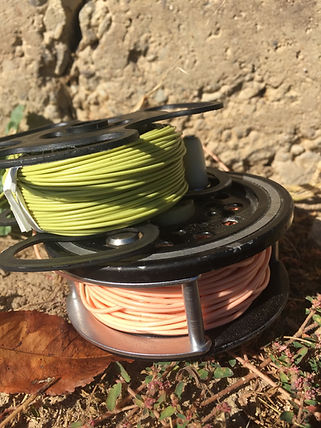What Does Fly Line Weight Mean?

The first fly lines ever used were made of woven horsehair and, eventually, woven silk fibers. I imagine many a fly fisherman back then spending long winter evenings building lines by lamplight and the frustrations they must’ve felt if they messed up and had to start again. With technological advancements and improved techniques for working with plastics, synthetic materials gradually replaced horsehair and silk. Today, fly lines are available in sizes and weights to accommodate almost any situation a fisherman may be presented with.
According to my research, the American Sportfishing Association in conjunction with the Cortland Line Company helped develop a fly line standard so that manufacturers could create a system for matching the right fly line to the right fly rod. Hence, the weighting system was born.
Fly lines range in weight from 1 to 15. 1-weight fly line is the lightest in terms of grains, while 15 is the heaviest. Typically, fly lines come in lengths of 90 feet. The weight of the line, however, is determined by the first 30 feet of that line. With that in mind, a fly line chart for weights 1 through 10 looks something like this:

1-weight 60 grains 16-28
2-weight 80 grains 14-28
3-weight 100 grains 12-24
4-weight 120 grains 10-22
5-weight 140 grains 6-18
6-weight 160 grains 4-16
7-weight 185 grains 2-14
8-weight 210 grains 1/0-10
9-weight 240 grains 2/0-8
10-weight 280 grains 4/0-2
There are also acceptable variations of weight between lines, usually plus or minus six to twelve grains. So a “standard” 5-weight line could weigh 134-146 grains and still be acceptable.
The weight of the fly line is critical in the delivery of the fly to the fish. The weight of the line is what loads the rod while casting, which creates kinetic energy which is then transferred to the spot where you wish the fly to land.
Lower weight lines are generally considered “finesse” lines. While delivering size 16 to 28 midges to small stream summer trout, for instance, a 1- or 2-weight would be your best choice. The weight is enough to cast very small flies while also creating the least amount of disturbance once it hits the water.
Also, the water in summer is low enough that current doesn’t play a big factor. In other words, you don’t need a line heavy enough to battle both the current and the fish, as you would in the spring when water levels are higher and currents are stronger. If you used a 1-weight line in the spring, you might not land many trout because you don’t have enough torque to actually wear out the fish before it finally throws the hook. For that reason, my go-to setup for spring trout fishing is a 4- or 5-weight line matched to a 4- or 5-weight fly rod.
My steelhead setup is a 7- or 8-weight line and rod combo. Steelhead are much bigger, harder fighting fish, so it takes a rod with a stiff backbone to wear them out enough to bring them to net. The quicker you can tire out a fish, the better your chances of landing it. I’ll also occasionally use this on larger waters such as the Clarion River where I sometimes need a little extra backbone to make a longer cast while still having enough torque to set the hook on a good fish.
Keep in mind, too, that it’s not absolutely necessary to match the line weight to the rod weight. One of my favorite setups for steelhead and big water fishing is an 8-weight rod coupled with a 7-weight line. The heavier rod makes it easier to cast the comparatively lighter line, which affords me more distance and control, both of which can be valuable assets when approaching spooky fish. Also, the heavier rod helps offset nasty wind and weather conditions that can affect casting to winter steelhead, while the lighter line delivers a better fly presentation.
With that said, though, I would never pair a rod with a line more than two sizes smaller or one size bigger. Too far outside of the weight range and you lose too much casting control and end up wasting energy trying to get the fly where you want it to go. That’s the whole reasoning behind rod and line weights, after all. If you match the right rod and line weight to the conditions and fish you are pursuing, you’ll find it much easier to cast and control your fly. In that regard, the above chart can really come in handy.
Sign up for the Dark Skies Fly Fishing e-newsletter
It's free, delivered to your inbox approximately three times each month. Your information is always kept private and used for the sole purpose of keeping you up to date on blog posts and specials in the online store.
Sign Up Now